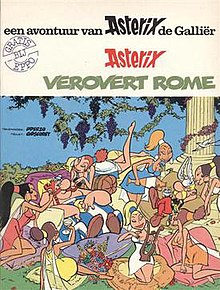
Asterix or The Adventures of Asterix is a bande dessinée comic book series about a village of indomitable Gaulish warriors who adventure around the world and fight the Roman Republic, with the aid of a magic potion, during the era of Julius Caesar, in an ahistorical telling of the time after the Gallic Wars. The series first appeared in the Franco-Belgian comic magazine Pilote on 29 October 1959. It was written by René Goscinny and illustrated by Albert Uderzo until Goscinny's death in 1977. Uderzo then took over the writing until 2009, when he sold the rights to publishing company Hachette; he died in 2020. In 2013, a new team consisting of Jean-Yves Ferri (script) and Didier Conrad (artwork) took over. As of 2021, 39 volumes have been released, with the most recent released in October 2021.

Asterix and the Great Divide is the twenty-fifth volume of the Asterix comic book series. First published in French in 1980, it was translated into English in 1981. It is the first Asterix adventure to be written by illustrator Albert Uderzo, following the death of Asterix co-creator and writer René Goscinny in 1977.
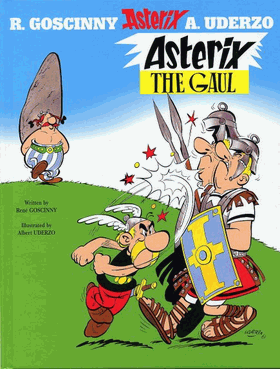
Asterix the Gaul is the first volume of the Asterix comic strip series, by René Goscinny (stories) and Albert Uderzo (illustrations). In Le Monde's 100 Books of the Century, a 1999 poll conducted by the French retailer Fnac and the Paris newspaper Le Monde, Asterix the Gaul was listed as the 23rd greatest book of the 20th century.

Asterix in Britain is the eighth in the Asterix comic book series. It was published in serial form in Pilote magazine, issues 307–334, in 1965, and in album form in 1966. It tells the story of Asterix and Obelix's journey to Roman-occupied Britain.

Dogmatix is a fictional white terrier dog who is a companion to Obelix in the Asterix comics. Dogmatix is a pun on the words dog and dogmatic. In the original French, his name is Idéfix, itself a pun on the French expression idée fixe meaning an obsession.
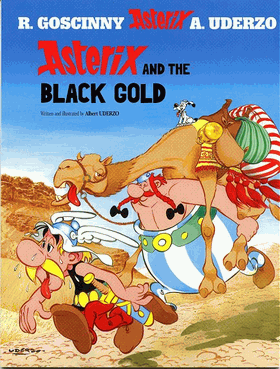
Asterix and the Black Gold is the twenty-sixth volume of Asterix comic book series, originally published in 1981. It is the second book to be both written and drawn by Albert Uderzo.

Asterix and the Magic Carpet is the twenty-eighth volume of the Asterix comic book series by René Goscinny (stories) and Albert Uderzo (illustrations). It was first published in 1987, and was translated into English in 1988. It is the fourth Asterix album to be published after the death of René Goscinny in 1977 and is thus both written and drawn by Albert Uderzo alone.
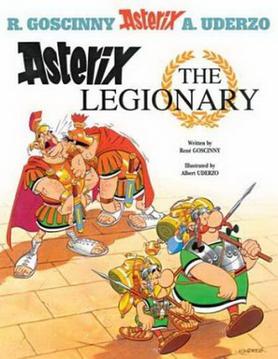
Asterix the Legionary is the tenth Asterix book in the Asterix comic book series by Rene Goscinny and Albert Uderzo. It was first published as a serial in Pilote magazine, issues 368–389, in 1966.

Asterix and the Normans is the ninth book in the Asterix comic book series, written by René Goscinny and drawn by Albert Uderzo. It was first published in serial form in Pilote magazine, issues 340–361, in 1966. It depicts a meeting between Asterix's Gaulish village and a shipfull of Normans (Vikings).
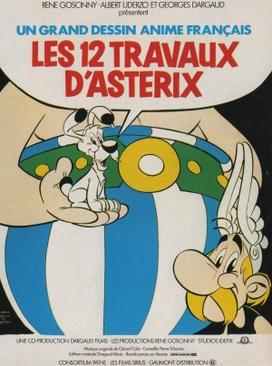
The Twelve Tasks of Asterix is a 1976 Belgian/French animated feature film based on the Asterix comic book series, and the third in the animated franchise. René Goscinny and Albert Uderzo, the creators of the series, wrote the story and directed the film themselves; with co-direction by Pierre Watrin and the screenplay co-written by Pierre Tchernia, a friend of Goscinny and Uderzo. The film was directed, produced and animated at Goscinny and Uderzo's own animation studio, Studios Idéfix and is the only Asterix animated film that has used the Xerography Process. At the time of its release, the film received mixed reviews since its tone is more cartoony and frequently breaks the fourth wall. Nowadays its reception is more favorable, with it often being cited as one of the best Astérix films, even reaching the status of a cult classic.

Asterix in Belgium is the twenty-fourth volume of the Asterix comic book series, by René Goscinny (story) and Albert Uderzo (illustrations).
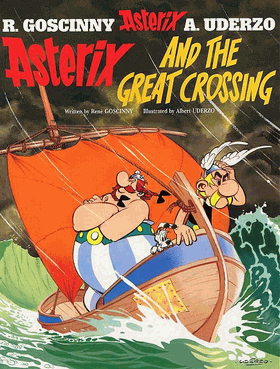
Asterix and the Great Crossing is the twenty-second volume of the Asterix comic book series, by René Goscinny (stories) and Albert Uderzo (illustrations).

Asterix and the Soothsayer is the nineteenth volume of the Asterix comic book series, by René Goscinny (stories) and Albert Uderzo (illustrations). It was originally serialized in Pilote issues 652-673 in 1972.

Asterix and the Laurel Wreath is the eighteenth volume of the Asterix comic book series, by René Goscinny (stories) and Albert Uderzo (illustrations). It was originally serialized in the magazine Pilote, issues 621–642, in 1971 and translated into English in 1974.

Asterix and Obelix All at Sea is the thirtieth volume of the Asterix comic book series, by Albert Uderzo. The album was dedicated to Uderzo's grandchild, as well as to the American actor Kirk Douglas.
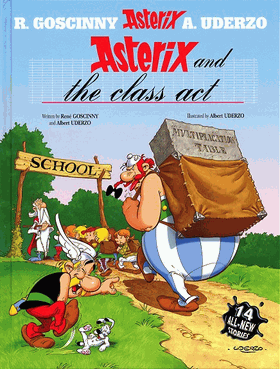
Asterix and the Class Act is officially the thirty-second album of the Asterix comic book series, by René Goscinny (stories) and Albert Uderzo, published in 2003. Unlike the other Asterix books, it is a compilation of short stories, rather than one long story. Each story has an introductory page giving some of its original history.
All the Asterix stories, created by René Goscinny and Albert Uderzo, have been translated into English. The vast majority of the albums were translated by Anthea Bell and Derek Hockridge. Their first volume, Asterix the Gaul, was published by Brockhampton Press in 1969. Bell retired in 2016 due to ill health and died in 2018; Hockridge died in 2013. Adriana Hunter currently serves as translator, with Asterix and the Chariot Race being her debut.
